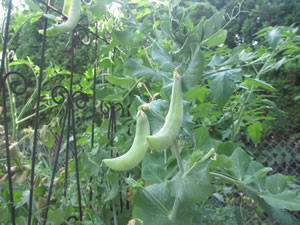To the new gardener, early spring planting can seem confusing. How are you supposed to put seeds in the ground when the ground is covered in snow, and you haven’t done anything in the way of loosening up the soil? They say to plant the peas on or around St. Patrick’s Day. But… snow? Huh?
For my first few years as a neophyte gardener, I just didn’t bother planting anything until May. The weather was just too confusing to me. But after having the garden beds for several gardening seasons in a row, I began to understand. The good garden soil is already there, waiting beneath the piles of snow. All you have to do is move the snow aside in one spot, fluff things up a bit, and put your seeds in. Done and done.
Things to consider before you plant:
How MUCH snow is out there? If your garden is buried under a foot of snow, then it may not make sense to plant peas so early because the ground will be wet and mucky for some time. This will rot your pea plants. If heavy snow is the case, wait until late March to put your peas in.
How frozen is the ground? You may be able to get away with planting your peas now if the soil is at least 50 degrees. Stick a soil thermometer in to test the temp before you go running for your packs of sugar, snow and snap peas.
Were your garden beds winterized? If you did the wise thing and covered your garden beds with mulch or straw over the winter, then all you have to do is pull back the covering over the area where you plant your peas, then give it a couple of days to warm up the soil.
To sprout, or not to sprout? Many gardeners have success sprouting their pea seeds in a wet paper towel for a few days before planting them. You soak the towel in warm water, add the seeds and place in a ziploc bag (keep the bag open to ventilate). Store the bag on top of the fridge for warmth, then check back in a day or two to see if the sprouting was a success.
So, to plant sweet peas in a garden bed that is only just now waking up from the winter freeze, do this:
Gather your materials. A garden shovel, spade, and pitchfork if you have one. A few packets of seeds (they’re dried peas), a yardstick or tape measure, and a pencil or stick to poke seed holes. Finally – a trellis! Peas are climbing plants. They will wind themselves around the nearest trellis, fence, pole, and if none are around they’ll try to climb up whatever tall plants are close by.
If you don’t have a trellis, you can use something else as a temporary way to mark the area where you planted the peas. Maybe a few stakes or bamboo poles. Oh – and let’s not forget your little plant labels to write PEAS on and insert into the ground so you can identify your little plants later.
March on out to the garden and tackle that snow. Chop it up with the shovel and move it out of the way. It’s okay if you only prepare a small spot in your garden bed and save the rest for later in the season. We like to have just a few pea plants for our small family. So I usually work the soil in a small space, turn it over, fluff it up, and then smooth out the top lightly. You can also sprinkle a little compost and work that in before smoothing it out.
Make holes. Once the little area is ready for planting, take out your yard stick or measuring tape and your little stick for hole-poking. Put the ruler on the ground and use the stick to poke holes that are each 1 inch deep, spaced 2 inches apart. If you want to plant five pea plants, then poke 5 holes.
Drop the seeds into the holes, one pea for each hole. If you’re afraid that they may not come up because you used old seeds or the weather is iffy, you can always plant a few more than you planned on having. This way, some pea plants may still survive. Cover the pea seeds with soil and pat down with your spade. Water lightly and evenly. Do not over fertilize.
Place your trellis or stakes very close to where each pea was planted. Once the plants grow to a foot or so, they will wind their little shoots around and begin to climb.
When can we eat them? Your pea plants will flower in May, and probably give you peas through the end of June. Fresh garden peas are delicious and so good for you! Pick them in the morning when they’re the crispest. Wait until the peas begin to bulge in their pods, but don’t let them get crinkly or the peas will dry out and lose their flavor. (Snow peas are flat, so this doesn’t apply to them.) If your peas do dry out in their pods, that’s okay too. You can store them for split pea soup in the winter!
